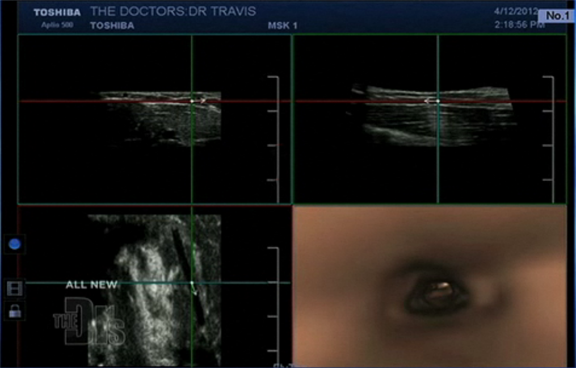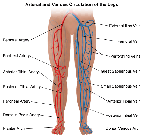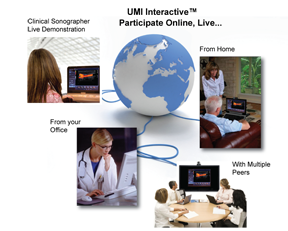Artifacts in ultrasound are more of a nuisance and can contribute to misleading diagnostic information. Artifacts can be attributed to a hardware problem such as holding the transducer incorrectly or be related to the imaging technique and software such as B-Mode or Doppler. However, scientists at the National Space Biomedical Research Institute (NSBRI) are developing an ultrasound technology that uses "Twinkling Artifact" to detect and push through kidney stones.
United Medical Instruments - Diagnostic Ultrasound Blog!
Biomedical Research Institute Develops Ultrasound Technology for Kidney Stones
Topics: ultrasound equipment, Doppler ultrasound, B-Mode technology, ultrasound service contracts, United Medical Instruments, Biomedical engineer, diagnostic ultrasound machine
New Fly Thru Ultrasound Technology from Toshiba Makes the Diagnosis
Topics: Toshiba Viamo, portable ultrasound machine, United Medical Instruments, UMI Blog, Diagnostic Ultrasound, laptop ultrasound machine, portable ultrasound system, compact ultrasound system, Used Ultrasound Machine, Toshiba Ultrasound, Fly Thru Ultrasound Technology
Which Portable Ultrasound Machine is Right for You?
Compact ultrasound, portable ultrasound machine, hand-held ultrasound system….. regardless of which name you use, the general category is still the same: small, laptop-sized ultrasound machine that, in most models, packs as much punch as its cart-based brothers. According to our guru in the ultrasound industry, Harvey Klein, portable ultrasound machines are defined as “compact ultrasound systems…..weighing 14 pounds or less, including handheld, hand-carried, and laptop machines.” Others don’t put the weight specification as a defining characteristic, but instead think of it as moveable between locations.
The main selling point being that as point-of care demands increase, the portable ultrasound machines can easily be used in the Emergency Department, small physician practice or sports medicine clinic, wherever imaging needs to be brought to the patient, avoiding the need for the patient to be moved. But the question is, which machine is right for you?Some physicians still believe that a full-sized 100 pound ultrasound machine is the only device that will yield the imaging results required to make a diagnosis. In many cases that’s just not true. Yes, 3D/4D technology requires more processing power that 2D imaging, and there are certain features that still can only be found on the cart-based ultrasound system. However, for many diagnostic imaging needs the portable ultrasound machine is the perfect solution – with its ease of use, comparable image quality, needle guided software, and affordable pricing.
At United Medial Instruments, Inc. we offer both new and used portable ultrasound machines. A quick breakdown follows:A 10-pound, fully shared service, easy to use machine with the following stand-out features:
- Panoramic Imaging
- Split Screen – show two images side by side while live scanning
- 3D imaging
- Needle Visualization
- Panoramic imaging
- Speckle reduction and compounding
- Intra-operative and laprascopic transducers for interventional procedures, including an exceptional 18MHZ high frequency probe
- Advanced Dynamic Flow – allows for directional color Doppler – see low flow every time
- Application-specific calculations
- Flexible modes with either tablet and touch-screen or keyboard
What are you waiting for?! Contact us today to schedule your FREE online virtual demo of one of these new compact ultrasound machines, visit our website to learn more, http://www.umiultrasound.com/ or give us a call, 877.490.7036.
Topics: Toshiba Viamo, portable ultrasound machine, United Medical Instruments, UMI Blog, Diagnostic Ultrasound, laptop ultrasound machine, portable ultrasound system, compact ultrasound system, point of care ultrasound, GE Logiq e, Siemens Acuson P300
A Sonographer's Opinion on Portable Ultrasound Machines
Compact ultrasound, Portable ultrasound machine, hand-held ultrasound system….. regardless of which name you use, the general category is still the same: small, laptop-sized ultrasound machine that, in most models, packs as much punch as its cart-based brothers. Recently I sat down with sonographer Grace Smith, RDMS (AB, OB/Gyn and RVT), ARRT – RT(R), owner of NWI Mobile Ultrasound to get her perspective on compact ultrasound machines.
Question: What is your background with ultrasound and experience level with both cart-based and portable ultrasound systems?
Answer: I have been a sonographer for a decade now, registered in OB, Abdominal, and Vascular, and have worked in the hospital setting for 5 years, including hospitals such as Johns Hopkins. I was the Program Director for ultrasound at Sanford-Brown College, and most recently have started my own mobile imaging company. While working in the hospital settings, I used a full-sized ultrasound system. However, I have seen excellent technology changes in portable ultrasound systems that make them comparable to the larger hospital-based systems.
Question: In your experience do you see the portable ultrasound market growing?
Answer: Yes, it’s definitely a growing industry. Unfortunately, there are many physicians who are not aware of the excellent image quality portable units provide. Some portable ultrasound machines are better than others, i.e. more powerful imaging, but in general, when compared to the larger systems, they hold their own.
Question: What are your thoughts on the SonoSite machines compared to the Toshiba Viamo portable ultrasound system?
Answer: I’ve used both systems in my mobile business and although the SonoSite has great image quality it lacks some features that the Viamo has. Our company provides sonograms of the heart (echocardiograms), abdomen, OB/GYN, Vascular including extremities, small parts, musculoskeletal and nerve blocks so we really need an ultrasound machine that can do everything well. We found this to be the case with the Toshiba Viamo and we especially like how user-friendly the system is with its unique touch-screen capability.
Question: It sounds like you have really embraced the laptop ultrasound market. What advice would you give to anyone looking to buy a portable ultrasound machine?
Answer: Well, as sonographers, we are required to go to school and complete the education and skills needed to acquire great diagnostic images. For physicians, I would suggest hiring a trained sonographer or acquiring the necessary education and scanning skills to get quality diagnostic images. This also includes learning the physics of ultrasound. Only trained personnel should scan patients.
To learn more about NWI Mobile ultrasound, please visit their website www.nwimobileultrasound.com. To discuss our portable ultrasound solutions, give us a call at 877.490.7036 or visit our website at www.umiultrasound.com and request a FREE online virtual demo!
Topics: portable ultrasound machine, United Medical Instruments, Mobile Ultrasound Company, Diagnostic Ultrasound, laptop ultrasound machine, portable ultrasound system
American College of Cardiology Guidelines for Vascular Ultrasound
Guidelines Established by American College of Cardiology for Appropriate Use of Ultrasound for Peripheral Vascular Testing
As reimbursement cuts continue to be made, determining if and when a diagnostic test is necessary is becoming more prevalent. The American College of Cardiology (ACC) collaborated with 10 other medical organizations to develop a set of guidelines to assist clinicians with their decision making process for diagnostic testing. The group focused on determining testing appropriateness for vascular ultrasound and functional testing for patients with suspected or known non-coronary arterial disorders.
Ultrasound is a cost-effective diagnostic tool that provides information to physicians needing to evaluate vascular blockages and disease in areas such as arteries of the neck, kidneys, abdomen, and lower extremities. In addition to be used as a screening measure, ultrasound is also used for determining the status post peripheral vascular procedures, such as arterial bypass, surgical removal of plaque (endarterectomy), or stenting.
The team used a rating scale coupled with timeframe intervals. According to the press release "The group found arterial vascular testing to be "appropriate" in about half of the clinical situations evaluated. Overall, vascular studies were deemed appropriate when clinical signs and symptoms were the main reason for testing. For example, Dr. Mohler explains it is reasonable to order a lower extremity vascular study for a patient who reports calf pain upon walking that resolves with rest. Tests that were conducted in patients with existing atherosclerotic disease or to establish a "baseline" after a revascularization procedure were also considered appropriate based on ratings."
- Ordering an ultrasound of the carotids or neck arteries in someone at low risk for heart attack or stroke.
- Screening for kidney artery disease in someone with peripheral artery disease with well controlled high blood pressure (hypertension) on one medication
- Choosing to perform an abdominal ultrasound in a patient with non-specific lower extremity discomfort
- Ordering a mesenteric artery ultrasound (arteries that supply the small and large intestines) as an initial test to evaluate the patient with chronic constipation or diarrhea
- Having current ultrasound technology in a clinician's facility is essential for careful diagnosis. To learn more about our recommended Toshiba Viamo portable ultrasound machine for vascular procedures, click here.
Topics: Toshiba Viamo, portable ultrasound machine, United Medical Instruments, UMI Blog, Diagnostic Ultrasound
Buying New or Used Ultrasound Machine? Demo Before you Buy!
As physicians struggle with the need to diversify patient services while managing their cash flow, one company has implemented an innovative program to help customers demo ultrasound equipment, online, before committing to a major purchase – a program which has increased customer satisfaction by ensuring the ultrasound machine meets their needs. Providing customers with ultrasound system demonstrations is not a new concept, all the large manufacturers like Siemens, Toshiba, and SonoSite typically go on-site to customer offices’ or hospital departments to demonstrate the equipment prior to purchase. Demoing a system is a great opportunity for customers to engage with a clinical person to ensure the ultrasound machine is going to meet their expectations: See image quality, verify software features for their clinical exams, and ask questions to a clinical expert. In these economic times, a private physician cannot risk spending thousands of dollars on capital equipment and have it not meet his or her needs.
United Medical Instruments, Inc. is a multi-vendor ultrasound reseller, selling both new and used ultrasound equipment, and now they offer its customers a new program to evaluate systems prior to purchase. It’s called UMI Interactive™ and it’s the first program of its kind where physicians and sonographers can evaluate ultrasound equipment prior to purchase.
Purchasing new or used ultrasound machines from a reputable ultrasound reseller is a good solution for those working with a budget. But on the flip side, there isn’t enough money built into these transactions to allow for onsite ultrasound system demonstrations. But with the UMI Interactive™, customers have the ability to schedule a convenient demo time and work directly with one of the registered staff sonographers to participate in live scanning and verify the system features and image quality meet their requirements.
To learn more about this program and schedule an online demo, click here. Explore United Medical Instruments, Inc. by visiting their website.
Topics: Toshiba Viamo, portable ultrasound machine, United Medical Instruments, UMI Blog, Diagnostic Ultrasound









